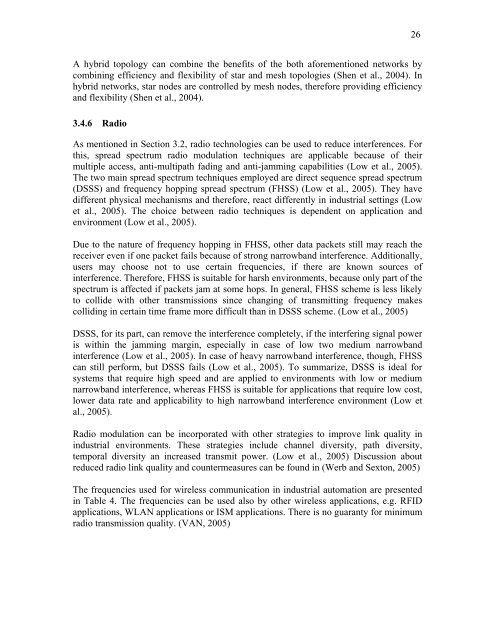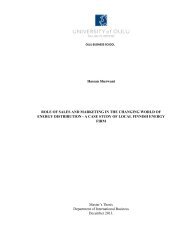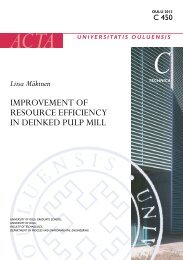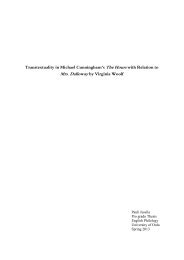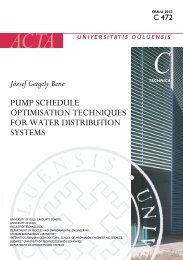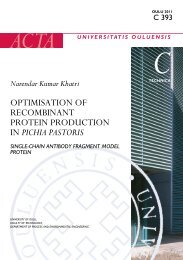Wireless Technologies in Process Automation - Herkules.oulu.fi - Oulu
Wireless Technologies in Process Automation - Herkules.oulu.fi - Oulu
Wireless Technologies in Process Automation - Herkules.oulu.fi - Oulu
You also want an ePaper? Increase the reach of your titles
YUMPU automatically turns print PDFs into web optimized ePapers that Google loves.
26<br />
A hybrid topology can comb<strong>in</strong>e the bene<strong>fi</strong>ts of the both aforementioned networks by<br />
comb<strong>in</strong><strong>in</strong>g ef<strong>fi</strong>ciency and flexibility of star and mesh topologies (Shen et al., 2004). In<br />
hybrid networks, star nodes are controlled by mesh nodes, therefore provid<strong>in</strong>g ef<strong>fi</strong>ciency<br />
and flexibility (Shen et al., 2004).<br />
3.4.6 Radio<br />
As mentioned <strong>in</strong> Section 3.2, radio technologies can be used to reduce <strong>in</strong>terferences. For<br />
this, spread spectrum radio modulation techniques are applicable because of their<br />
multiple access, anti-multipath fad<strong>in</strong>g and anti-jamm<strong>in</strong>g capabilities (Low et al., 2005).<br />
The two ma<strong>in</strong> spread spectrum techniques employed are direct sequence spread spectrum<br />
(DSSS) and frequency hopp<strong>in</strong>g spread spectrum (FHSS) (Low et al., 2005). They have<br />
different physical mechanisms and therefore, react differently <strong>in</strong> <strong>in</strong>dustrial sett<strong>in</strong>gs (Low<br />
et al., 2005). The choice between radio techniques is dependent on application and<br />
environment (Low et al., 2005).<br />
Due to the nature of frequency hopp<strong>in</strong>g <strong>in</strong> FHSS, other data packets still may reach the<br />
receiver even if one packet fails because of strong narrowband <strong>in</strong>terference. Additionally,<br />
users may choose not to use certa<strong>in</strong> frequencies, if there are known sources of<br />
<strong>in</strong>terference. Therefore, FHSS is suitable for harsh environments, because only part of the<br />
spectrum is affected if packets jam at some hops. In general, FHSS scheme is less likely<br />
to collide with other transmissions s<strong>in</strong>ce chang<strong>in</strong>g of transmitt<strong>in</strong>g frequency makes<br />
collid<strong>in</strong>g <strong>in</strong> certa<strong>in</strong> time frame more dif<strong>fi</strong>cult than <strong>in</strong> DSSS scheme. (Low et al., 2005)<br />
DSSS, for its part, can remove the <strong>in</strong>terference completely, if the <strong>in</strong>terfer<strong>in</strong>g signal power<br />
is with<strong>in</strong> the jamm<strong>in</strong>g marg<strong>in</strong>, especially <strong>in</strong> case of low two medium narrowband<br />
<strong>in</strong>terference (Low et al., 2005). In case of heavy narrowband <strong>in</strong>terference, though, FHSS<br />
can still perform, but DSSS fails (Low et al., 2005). To summarize, DSSS is ideal for<br />
systems that require high speed and are applied to environments with low or medium<br />
narrowband <strong>in</strong>terference, whereas FHSS is suitable for applications that require low cost,<br />
lower data rate and applicability to high narrowband <strong>in</strong>terference environment (Low et<br />
al., 2005).<br />
Radio modulation can be <strong>in</strong>corporated with other strategies to improve l<strong>in</strong>k quality <strong>in</strong><br />
<strong>in</strong>dustrial environments. These strategies <strong>in</strong>clude channel diversity, path diversity,<br />
temporal diversity an <strong>in</strong>creased transmit power. (Low et al., 2005) Discussion about<br />
reduced radio l<strong>in</strong>k quality and countermeasures can be found <strong>in</strong> (Werb and Sexton, 2005)<br />
The frequencies used for wireless communication <strong>in</strong> <strong>in</strong>dustrial automation are presented<br />
<strong>in</strong> Table 4. The frequencies can be used also by other wireless applications, e.g. RFID<br />
applications, WLAN applications or ISM applications. There is no guaranty for m<strong>in</strong>imum<br />
radio transmission quality. (VAN, 2005)


